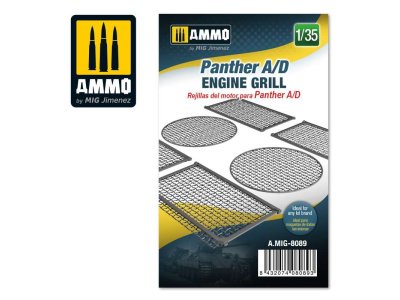1:35 Takom 2100 Panther A Mid-Late Production Zimmerit w/Full Interior Plastic Model kit
When the German Panzer IV met the Russian T-34 in June 1941, they were humiliated by being outclassed by the T-34, so a group of weapons specialists were sent to the Russian front to analyze the T-34’s design.
With these results, Daimler- Benz (DB) and Maschinenfabrik Augsburg (MAN) were both tasked with providing designs for a 30-ton medium tank by April 1942. The MAN design was accepted in May 1942, mainly because it was able to use an existing turret designed by Rheinmetall-Borsig, saving valuable time needed to design a new turret required with the DB design.
The Panther design adapted many of its successful design characteristics from the T-34. These were mainly the sloped armor, and the wide tracks (to make maneuvering in snow conditions of the Eastern front easier). In September 1942 the first prototype was tested and immediately pressed into service. Despite delays in production due to the lack of manufacturing equipment of the hull, the first rushed deliveries to the German Army were completed in December, but the tank was plagued by technical problems. Despite these early issues, the tank was very successful, and due to its high demand on the Eastern Front, the original production of 250 tanks per month at the MAN plant, was increased to 600 tanks per month in January in 1943, which resulted in production also being allocated to the Daimler-Benz, Maschinenfabrik Niedersachsen-Hannover (MNH), and the Henschel & Sohn plants to meet production quotas. Due to Allied bombing throughout the war, the required production amount was never met and only 6,000 in total were built.
The 700hp Maybach V-12 petrol engine with its seven-speed AK 7-200 synchromesh gearbox designed by ZF, was fitted with a governor in late 1943 to minimize engine failures by limiting the engine revolutions to 2500 rpm and reducing its power to 600 hp. This reduced the Panthers top speed from 55 km/h to 46 km/h. The Panther had a five-man crew: the driver, radio operator, gunner, loader, and commander.
The Panther was armed with a semi-automatic 75mm Rheinmetall-Borsig KwK 42 main gun, and could carry 79 rounds of three different types of ammunition: Armour-Piercing Capped Ballistic Capped, (APCBC), High-Explosive (HE) and Armour-Piercing Composite Rigid (APCR). The 75mm cannon on the Panther was one of the most powerful cannons of WWII, and had even greater success at piercing enemy armour than the Tiger I’s 88mm cannon. The Panther was also equipped with two 7.92mm Maschinengewehr 34 (MG-34) for close quarter fighting; one was mounted coaxially with the main cannon and the second was mounted in the front sloping armour and operated by the radio operator. In later production upgrades, a mount was attached to the commander’s cupola so a third MG-34 could be mounted for anti-aircraft purposes.
The frontal armor of the Panther consisted of 80mm homogeneous steel plate sloped back at 55 degrees from the vertical, interlocked & welded for strength. This made the Panther’s frontal armor less penetrable to Allied and Soviet tanks. The front of the turret was covered by a 100mm cast mantlet in the shape of a semi-circle, with a curved shape meant to deflect incoming shells. To keep weight down, sacrifice was made to its side armor, which was on average 40mm to 50mm thick, leaving the Panther vulnerable to attacks from the sides by Allied and Soviet tank and anti-tank guns.
| Country | Germany |
| Release date | 2021-08 |








